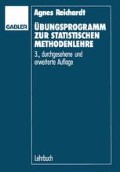Zusammenfassung
Im Folgenden sollen nur quantitative oder quantifizierte Merkmale betrachtet werden. Das Ergebnis einer Erhebung ist zunächst eine Masse von Informationen. Um die durch die Erhebung gewonnene Information übersichtlich zu gestalten, ist es zweckmäßig.die Elemente zusammenzufassen, die bezüglich eines Merkmals die gleiche Ausprägung besitzen. Die Anzahl der Elemente, die die Ausprägung a r des betrachteten Merkmals M A aufweisen, heißt absolute Häufigkeit von a r , f r = n [{e i | x i = a r }].
Access this chapter
Tax calculation will be finalised at checkout
Purchases are for personal use only
Preview
Unable to display preview. Download preview PDF.
Author information
Authors and Affiliations
Rights and permissions
Copyright information
© 1992 Springer Fachmedien Wiesbaden
About this chapter
Cite this chapter
Reichardt, Á. (1992). Häufigkeitsverteilungen. In: Übungsprogramm zur statistischen Methodenlehre. Gabler Verlag, Wiesbaden. https://doi.org/10.1007/978-3-663-14872-2_2
Download citation
DOI: https://doi.org/10.1007/978-3-663-14872-2_2
Publisher Name: Gabler Verlag, Wiesbaden
Print ISBN: 978-3-409-63823-4
Online ISBN: 978-3-663-14872-2
eBook Packages: Springer Book Archive

